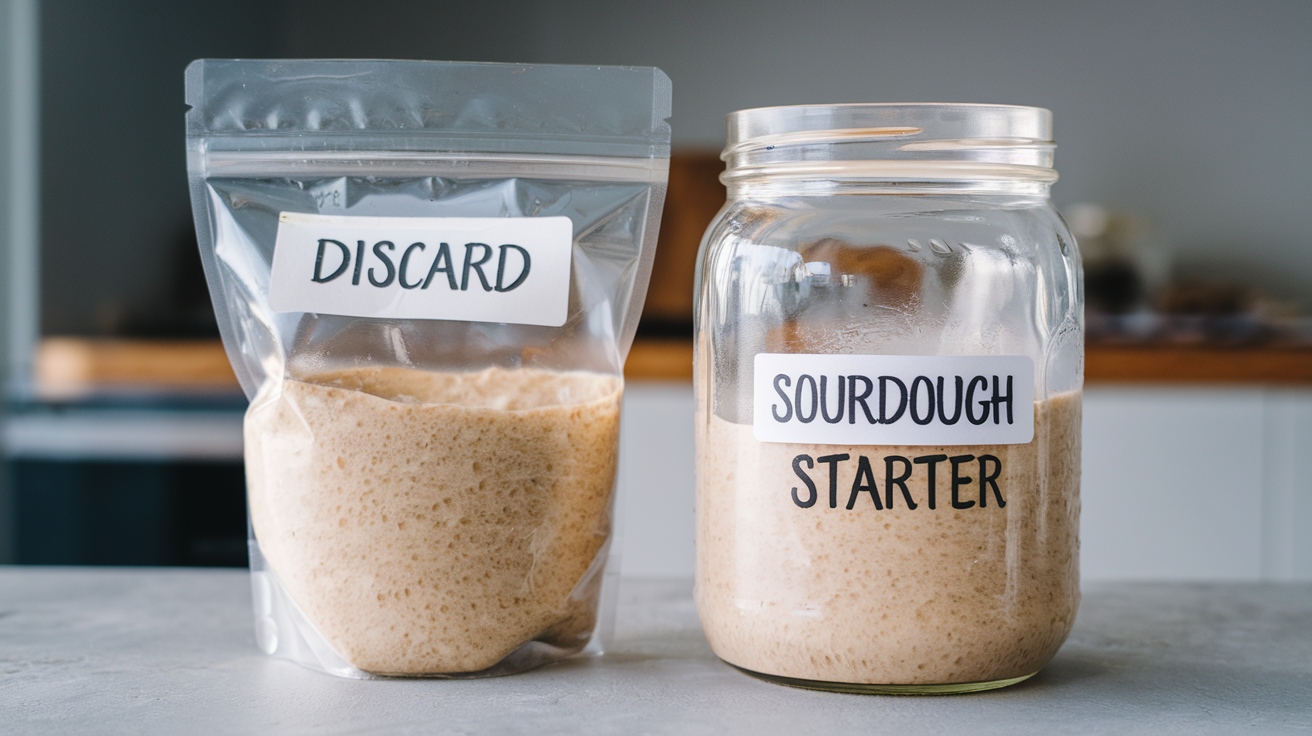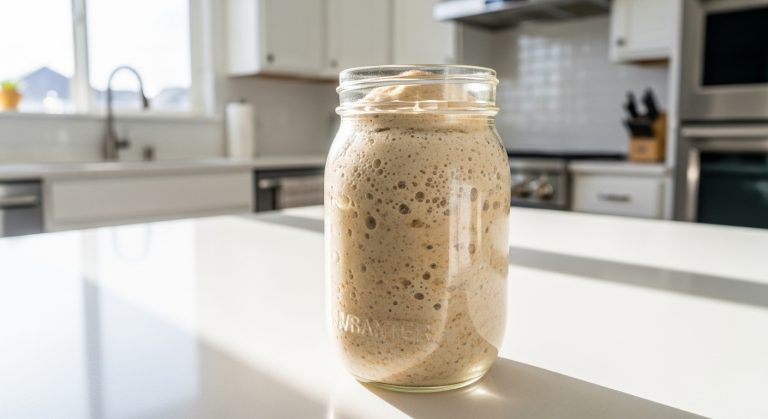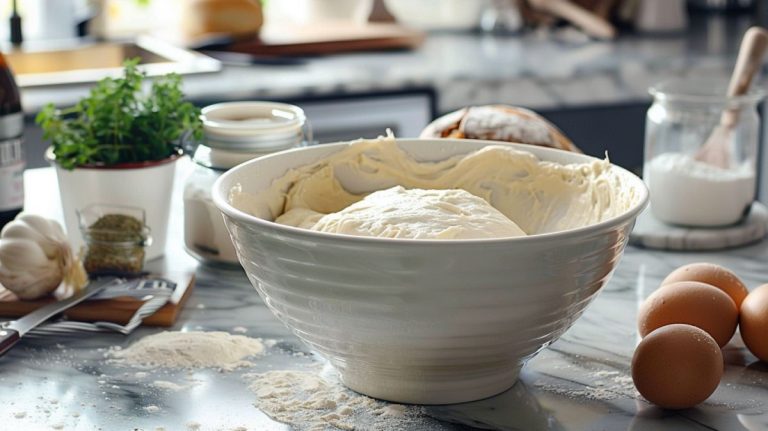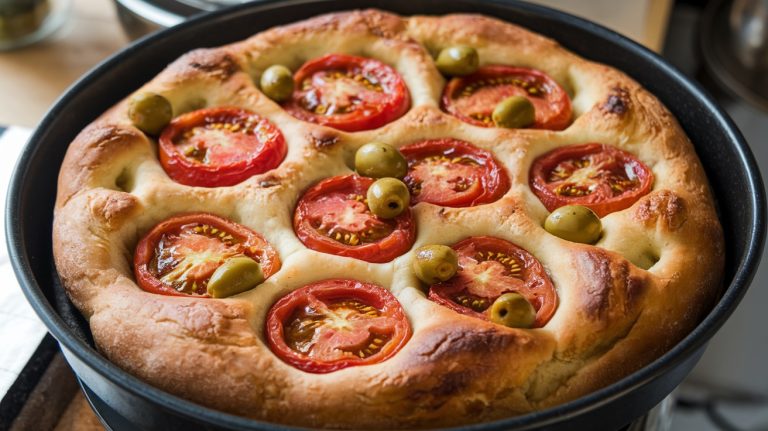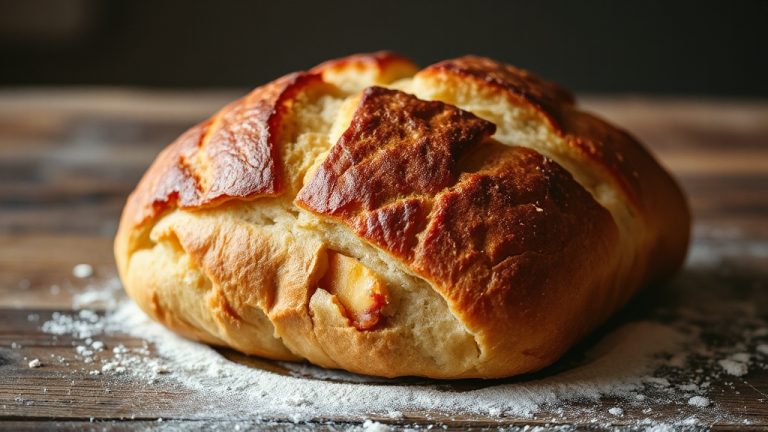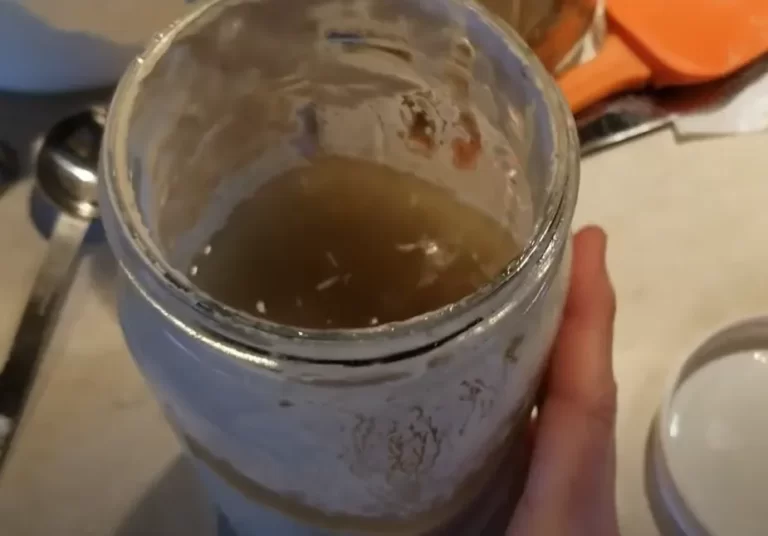Difference Between Sourdough Starter and Discard: The Showdown
The difference between sourdough starter and sourdough discard lies in their uses and activity levels. Your sourdough starter is a lively culture that ferments flour and water, making it ideal for bread as it rises quickly.
In contrast, discard is the portion you remove before feeding your starter. It’s less active but still adds flavor and moisture to recipes like pancakes and muffins. While the starter requires regular feeding, discard can be stored for weeks.
Understanding these distinctions can open up new baking opportunities, and there’s plenty more you can learn about maximizing your sourdough journey.
Key Takeaways
- Sourdough starter is a living culture that ferments and leavens bread, while sourdough discard is a less active portion removed before feeding.
- Active starter doubles in size within 4-12 hours, whereas discard has reduced leavening power and contributes less to dough rise.
- Discard retains flavor and moisture, making it ideal for recipes like pancakes and cookies, unlike the starter which is essential for traditional bread.
- The starter requires regular feeding every 12-24 hours, while discard can be stored in the refrigerator for up to two weeks.
- Discard enhances baked goods with sour notes and tenderness, benefiting from its acidity that prevents tough gluten development.
How Do You Know If It’s a Sourdough Starter or a Discard?
Understanding the difference between sourdough starter and discard is essential for any home baker. A sourdough starter is a living culture made from flour and water. It ferments over time, capturing wild yeast and bacteria vital for leavening your bread. This active culture is typically bubbly and doubles in size after feeding, making it perfect for recipes that require significant leavening power.
On the other hand, sourdough discard is the starter portion you remove before feeding it. While it retains some leavening properties, it’s less active than the fully fed starter. You can store your discard in the refrigerator for up to two weeks or even freeze it for longer storage. Discarding half of the starter before feeding helps maintain a balanced microbial environment, ensuring optimal flavor and texture in your baked goods.
Despite its reduced activity, discard is versatile and enhances your baking. You can use it in various sourdough discard recipes where leavening isn’t as critical. Think pancakes, waffles, or even cookies!
Key Differences Between Starter and Discard
When you compare sourdough starter and discard, you’ll notice a clear difference in their activity levels.
The starter is lively and ready to help your bread rise, while the discard is less active and better suited for delicious recipes like pancakes or muffins.
Understanding these distinctions can help you make the most of your sourdough baking experience. Additionally, using sourdough discard can significantly reduce food waste while enhancing your culinary creations.
Activity Level Comparison
Sourdough starter and discard differ greatly in their activity levels, impacting how you use them in baking. A mature sourdough starter boasts a high activity level thanks to a vibrant wild yeast and bacteria community. When fed, it can double in size within 4-12 hours, making it an excellent leavening agent. This robust activity enhances your dough’s rise, creating airy, flavorful bread.
In contrast, sourdough discard has reduced activity. Since it’s unfed and removed from the starter, its leavening properties are minimal. While it retains some fermentation benefits, it’s better suited for recipes that don’t rely heavily on rising, such as pancakes or muffins. You can use discard immediately after removal, but don’t expect it to provide the same lift or structure as your active starter.
The fermentation process in the starter creates a higher concentration of gas bubbles, which is essential for gluten development. Discarding adds flavor without considerably aiding in dough rise. Proper feeding cycles are crucial for maintaining the activity and health of your starter.
Regularly managing your starter by discarding some before feeding guarantees its health, allowing you to enjoy the benefits of both the active starter and the versatile discard.
Usage in Recipes
In countless recipes, the choice between using a sourdough starter and sourdough discard can significantly affect the final product. When you’re baking bread, the active sourdough starter is your best friend. Its high yeast content provides the essential leavening power, ensuring your loaves rise beautifully.
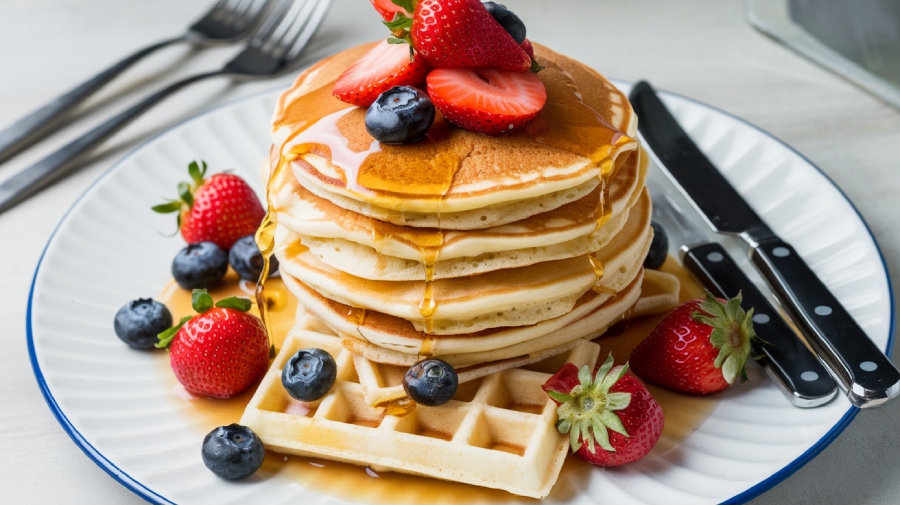
However, if you’re whipping up pancakes or muffins, sourdough discard shines. While it retains some leavening properties, it’s less potent than a starter, making it perfect for recipes where a robust rise isn’t as critical.
In these cases, you can use discard for its moisture and flavor-enhancing qualities. Simply mix it in right after removal from the starter, and you’ll enjoy the delightful sour notes it adds. The acidity in sourdough discard also helps yield tender baked goods by preventing tough gluten development. Additionally, using cold fermentation can further enhance the flavor profile of your baked goods, even when using discard.
Conversely, for recipes that depend on structure and height, please rely on your active starter, ideally when it’s doubled in size.
Baking Applications for Each
Understanding the baking applications of sourdough starter and discard can elevate your culinary creations.
Sourdough starter serves as a powerful leavening agent, essential for creating airy, flavorful breads. When you wait for it to double in size and become bubbly, you’re ensuring it’s at its peak for ideal rise. Use it in traditional sourdough loaves or any recipe that requires significant leavening.
On the other hand, sourdough discard is your secret weapon for enhancing flavor without the need for extensive leavening. You can immediately incorporate discard into recipes like pancakes, muffins, and brownies. It retains some leavening properties and adds a delightful tang that helps tenderize baked goods. Additionally, using sourdough discard in your recipes can help minimize food waste, allowing you to make the most of your sourdough baking experience.
As a rule of thumb, you can replace up to one-third of the flour in your recipes with discard, minimizing waste while maximizing taste.
Maintenance and Storage Practices
To keep your sourdough starter thriving, you’ll need to feed it regularly, especially if it’s at room temperature. Meanwhile, proper storage is key to maintaining the quality of sourdough discard, whether refrigerated or frozen.
Understanding these maintenance practices will guarantee that your starter and discard remain healthy and useful for your baking adventures. Regular checks for signs of health ensure that your starter and discard are in optimal condition for baking.
Starter Feeding Frequency
Regularly feeding your sourdough starter is crucial for keeping it lively and healthy. Ideally, you should feed your starter every 12 to 24 hours at room temperature. This consistent feeding maintains its activity, allowing it to rise and develop that wonderful tangy flavor.
A commonly recommended feeding ratio is 1 part starter to 3 parts flour and 3 parts water. This helps balance the growth and acidity, ensuring your starter remains robust without becoming overly sour.
If you prefer to store your sourdough starter in the refrigerator, you can reduce the feeding frequency to once a week. However, before using it again, you’ll likely need to bring it back to life with a few room temperature feedings to regain its vigor. Regular feedings ensure that your starter remains active and potent, allowing you to achieve consistent baking results.
As for your discard sourdough starter, remember that it can be collected and stored in the fridge for up to two weeks. For the best quality and flavor, aim to use it within a week.
Always label your containers with dates to keep track of freshness. This ensures you make the most of your starter and discard it.
Discard Storage Guidelines
After you’ve fed your sourdough starter, it’s easy to accumulate discard, which can be a valuable ingredient if stored properly.
To keep your sourdough discard fresh, use a sealed container to prevent contamination. When stored airtight in the refrigerator, it can last up to two weeks. For longer-term storage, consider freezing small portions, around 50-100g, which will allow you to maintain quality for several months.
It’s wise to label your containers with the date you stored them. This helps you track freshness and guarantees you use the discard within a reasonable timeframe. You can combine discard from multiple days before baking, but remember to let it come to room temperature for ideal incorporation into your recipes.
While hooch, the black liquid that sometimes forms on top, is perfectly normal, any signs of spoilage, like mold or off smells, mean it’s time to toss that batch. Regularly feeding your starter and managing discard volume can help keep your sourdough starter healthy and active.
Creative Uses for Discard
Embracing your sourdough starter’s discard opens up a world of culinary creativity that can elevate your baking game. By utilizing this often-overlooked ingredient, you can enhance flavors and moisture in a variety of delicious ways.
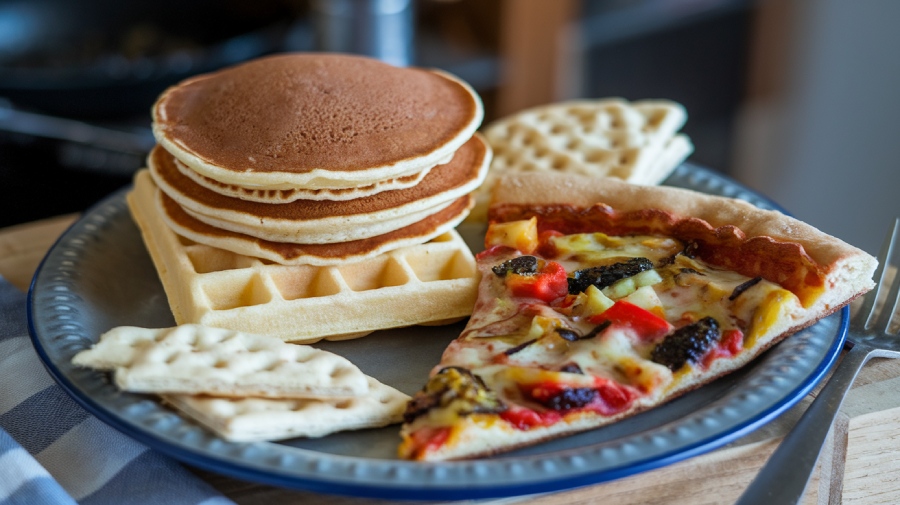
Here are three creative uses for sourdough discard:
- Pancakes and Waffles: Incorporate sourdough discard into your batter for added tanginess and moisture. Just replace up to one-third of the flour to maintain that perfect fluffy texture.
- Savory Pizza Dough: Add sourdough discard to your pizza dough for improved chewiness and a depth of flavor that will impress family and friends.
- Sourdough Crackers: Transform your discard into crunchy, flavorful crackers that make for an irresistible snack, highlighting the distinct sourdough taste.
Beyond these, consider enriching banana bread or chocolate chip cookies with sourdough discard. Not only does it boost flavor, but its fermentation also enhances the nutritional profile.
Frequently Asked Questions
Can Sourdough Discard Be Used as Starter?
Oh sure, just toss that sourdough discard into the ring and call it a starter!
It’s like giving a sleepy cat a cup of coffee. While it’s got some yeast and bacteria, it’s not as lively as a freshly fed starter.
If you feed it flour and water, let it frolic at room temperature, and watch for bubbles, you might just have a contender.
Is Starter the Same as Discard?
No, starter isn’t the same as discard.
Your starter is an active mixture of flour and water, full of wild yeast and bacteria, ready to leaven bread.
Discard, on the other hand, is the portion you remove before feeding the starter.
While it still has some leavening properties, it’s less potent and often used in various recipes to reduce waste.
What Is the Difference Between Discard and Active Starter?
You know what they say, “One man’s trash is another man’s treasure.” In the world of sourdough, that rings true.
An active starter is your lively mixture of flour and water, bubbling with wild yeast and ready to rise. In contrast, discard is the leftover, unfed portion—less active but still useful.
While the starter leavens bread beautifully, discard shines in recipes like pancakes and brownies, turning what could be waste into delicious treats!
What’s the Point of Using Sourdough Discard?
Using sourdough discard adds depth and character to your baking.
It’s a fantastic way to prevent food waste while infusing your recipes with a delightful tang. You can incorporate it into pancakes, muffins, or even quick breads, enhancing their flavor and moisture.
Plus, the fermentation process improves the nutritional value and shelf life of your baked goods.
Starter vs. Discard: A Baker’s Guide to Culinary Wonders
In the delightful dance of dough, understanding the difference between sourdough starter and discard opens up a world of wonders. Your starter, a bubbly beacon of bread-making brilliance, nurtures delicious loaves, while discard, the versatile treasure trove, offers endless culinary creativity.
Embrace both in your baking journey, and you’ll transform simple ingredients into scrumptious sensations. You’ll elevate your sourdough skills with a little love and care, crafting enchanting creations that tantalize taste buds and warm hearts.

